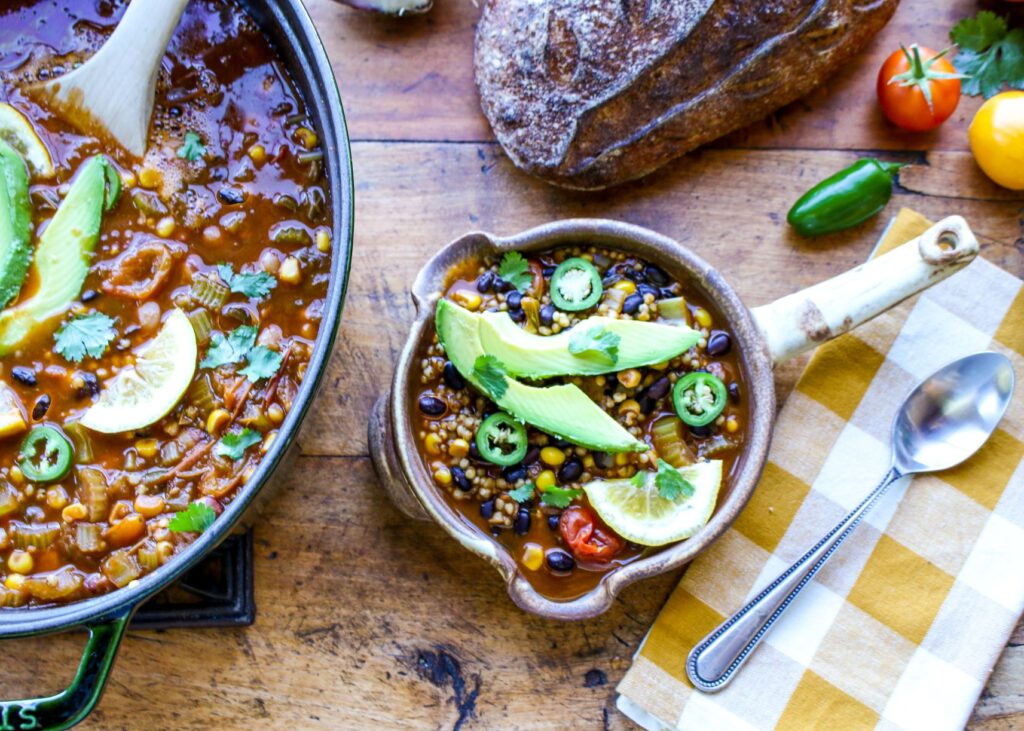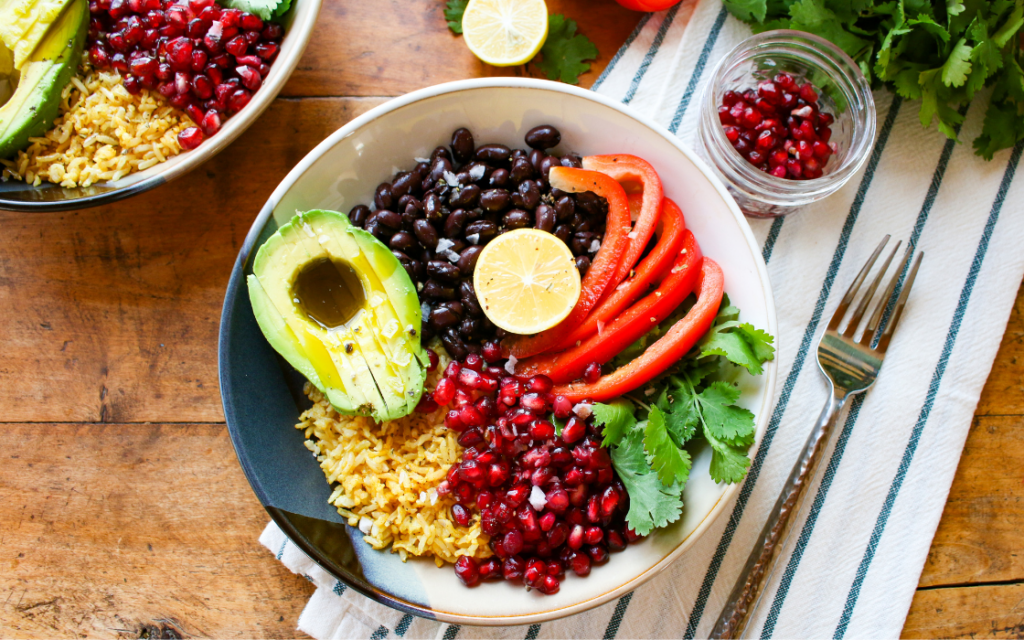Suffering from celiac disease or gluten sensitivities? So, how can you go gluten free? Check out this easy guide of common gluten-containing foods to get started.
An estimated 1 in 133 Americans, or about 1% of the population, has celiac disease. Celiac disease is a genetic autoimmune disorder that damages the small intestines. The small intestine is damaged by ingesting gluten, which produces an immune response. This immune response attacks the villi of the small intestines. Nutrients are not absorbed properly when villi are destroyed. A 100% gluten-free diet is the only existing treatment for celiac disease today. However, if you need to avoid gluten in your diet, it doesn’t mean you have to give up on eating an overall healthy, plant-based diet that’s good for your whole body. Read more about eating a plant-based and gluten-free diet here.

What is Gluten?
Gluten is a mixture of proteins found in wheat and related grains, such as barley, rye and all their species and hybrids. Gluten helps foods maintain their shape, acting as a glue that holds the food together. If you suffer from celiac disease or gluten intolerance, it is imperative to know if gluten is in your food and even your beauty care products. So many foods and products that you may assume are gluten-free may not be. As you become more proactive with what is going inside your body—even on your skin—your body will become happier and healthier. It’s important to note that there are no health benefits for removing gluten from your diet without medical necessity, such as a diagnosis of celiac disease, gluten intolerance, non-celiac gluten sensitivity, wheat allergies, or other medical conditions that might make forgoing gluten a necessity.

Foods that Commonly Contain Gluten
The following foods commonly contain gluten, but it’s important to read your labels, too. While many of these items traditionally contain gluten, special varieties may be available. Look for the gluten free products certification mark as a sign that the products are gluten-free, as well as the Certified Gluten-Free mark.
- Breaded meat, poultry or seafood
- Pasta
- Bread, sandwich buns
- Pizza crust
- Muffins, bagels
- Cake, doughnuts, pancakes
- Crackers
- Cereal
- Granola
- Noodles

Surprising Foods that may Contain Gluten
The following foods may sneak in gluten into the formulation, even though you might not suspect it. While these foods may be inherently gluten-free, added ingredients can make an impact. Read your food labels and inquire at restaurants to be safe. Look for the gluten free products certification mark as a sign that the products are gluten-free, as well as the Certified Gluten-Free mark.
- Restaurant egg dishes (some restaurants put pancake batter in their eggs.)
- Oats and other whole grains (they are naturally free of gluten, but are often cross-contaminated with gluten)
- French fries (some are cooked in batter)
- Potato chips (some have seasonings made with malt vinegar or wheat starch)
- Processed lunch meats (may be filled with a wheat flour for texture)
- Candy bars (some may contain wheat or barley malt)
- Brown rice syrup (may have barley enzymes)
- Meat substitutes (some are made with wheat gluten and are breaded)
- Salad dressings (may contain malt vinegar, soy sauce, or flour)
- Communion wafers (usually made from wheat)
- Canned soup (thickeners may be made from wheat)
- Pickles made with Malt Vinegar (Vlastics and Heinz’s are free of gluten)
- Chewing Gum (may include gluten based powder to keep gum from sticking)

Whole Plant-Based Foods that Are Gluten-Free
Just because you are going gluten-free, it doesn’t mean you have to give up on healthy, plant-based foods in your life. These foods are naturally free of gluten. Remember to check labels of food products to understand whether ingredients have been added or cross-contamination has occurred in food production.
- Pulses: beans, lentils, peas
- Gluten-free whole grains: amaranth, buckwheat, brown rice, millet, oats (look for gluten-free), sorghum, teff, quinoa
- Tofu
- Nuts: almonds, hazelnuts, macadamia nuts, pecans, pistachios, walnuts
- Seeds: chia, flax, hemp, pumpkin, sesame, sunflower
- Peanuts and peanut butters
- Nut and seed butters
- Vegetables
- Fruits
- Garlic, ginger
- Whole spices and herbs (without extra ingredients)

Helpful Tips for Going Gluten-Free
You can still enjoy delicious gluten-free eating, from gluten free pizza to gluten free snacks with the following tips.
1. Tackling Gluten Free Restaurants and Stores.
Be inquisitive when purchasing food at restaurants. Address questions to the food server, chef, or store clerk in order to know for sure if an item has gluten.
2. Research online.
You can find valuable information from reputable websites, such as Beyond Celiac and the Gluten Intolerance Group, as well as peer-reviewed articles on living a healthful lifestyle. as well as peer-reviewed articles on living a healthful gluten-free lifestyle.
Most importantly, talk to a health care practitioner, such as a registered dietitian, if you are transitioning to a gluten-free lifestyle. Getting educated on eating healthfully on a gluten-free diet is important. You can schedule a personalized appointment with my registered dietitian team experienced in plant-based gluten-free diets here.
3. Be aware of gluten free labeling.
According to the FDA’s regulation, “gluten-free” is a voluntary claim that manufacturers may elect to use in the labeling of their foods. However, manufacturers that label their foods “gluten-free” are accountable for using the claim in a truthful and not misleading manner, and for complying with all requirements established by the regulation and enforced by FDA. Look for the following labels on food items:
- Gluten-free
- Free of gluten
- No gluten
- Without gluten
4. Always read the ingredient label on all food items, looking for gluten-containing ingredients.
Make it a habit. And look for hidden gluten additives in food products:
- Brown rice syrup (maybe made with barley enzymes)
- Starch or dextrin (could be from any grain, including wheat)
- Malt (malted barley flour, malted milk or milkshakes, malt extract, malt syrup, malt flavoring, malt vinegar)
- Artificial Colors (could contain wheat)
- Maltodextrin (Under the Food Labeling and Consumer Protection Act, if an FDA regulated food product contains maltodextrin and the maltodextrin contains protein derived from wheat, the word wheat must be included on the food label; e.g., maltodextrin (wheat).)
- Citric acid (can be fermented from wheat, corn, molasses or beets)
Check out some of my favorite plant-based gluten free recipes here:
Chia Seed Pudding with Berries
Apple Cinnamon Oatmeal with Pistachios
Lima Bean Salad with Sumac Spice
Written by Sharon Palmer, MSFS, RDN with Tamara Kelly-Scott, dietetic intern
Photos by Sharon Palmer
References:
Celiac Disease Foundation. What is Celiac Disease. Https://celiac.org/celiac-disease/understanding-celiac-disease-2/what-is-celiac-disease/. Accessed October 18, 2016.
CELIAC DISEASE: FAST FACTS. Celiac Beyond website. https://www.beyondceliac.org/celiac-disease/facts-and-figures/. Accessed October 31, 2016.
Celiac Disease Foundations. https://celiac.org/live-gluten-free/glutenfreediet/sources-of-gluten/. Accessed October 31, 2016.
Food and Drug Administrations. Gluten and Food Labeling. https://www.fda.gov/Food/GuidanceRegulation/GuidanceDocumentsRegulatoryInformation/Allergens/ucm367654.htm. Accessed November 1, 2016










